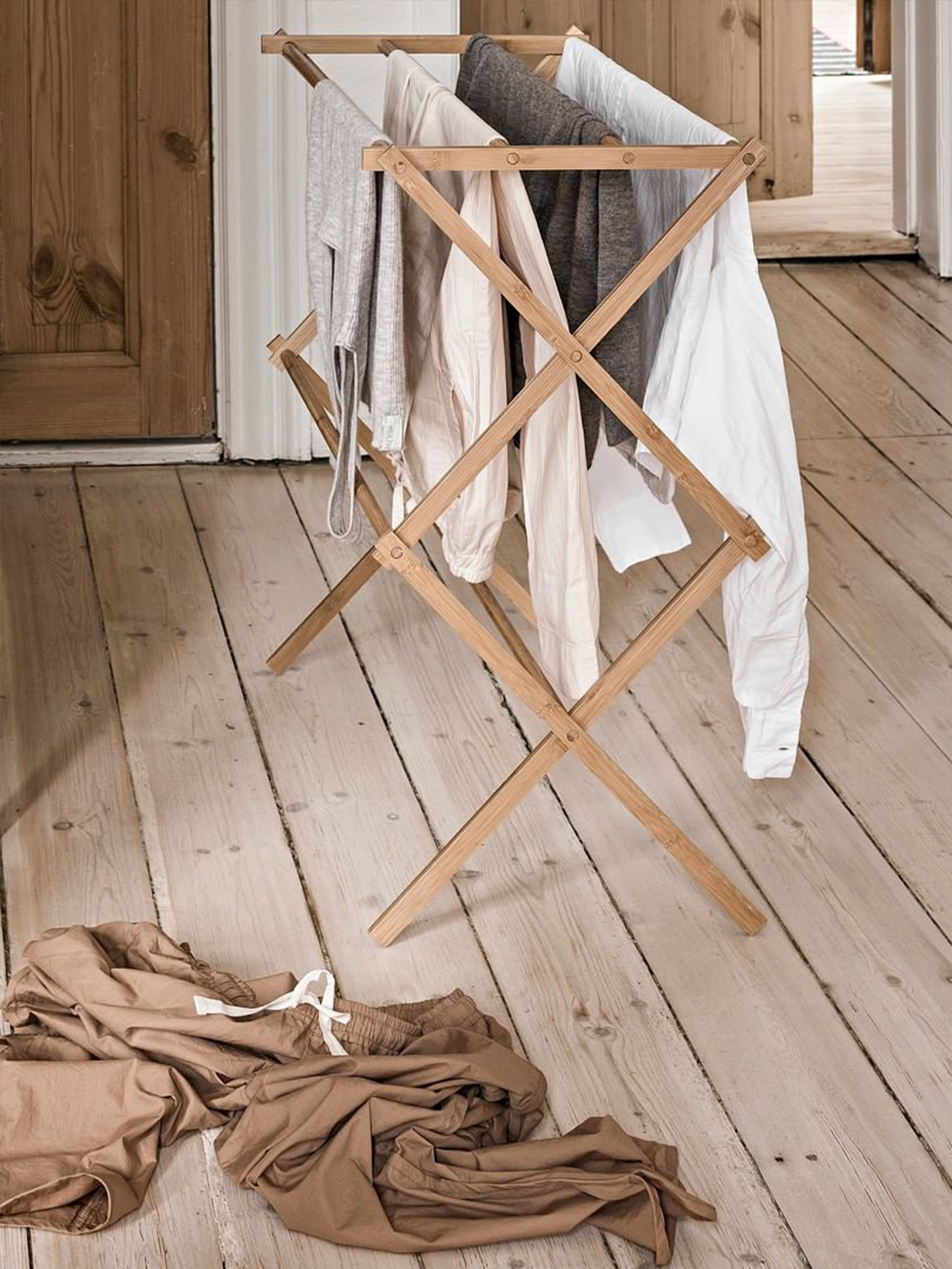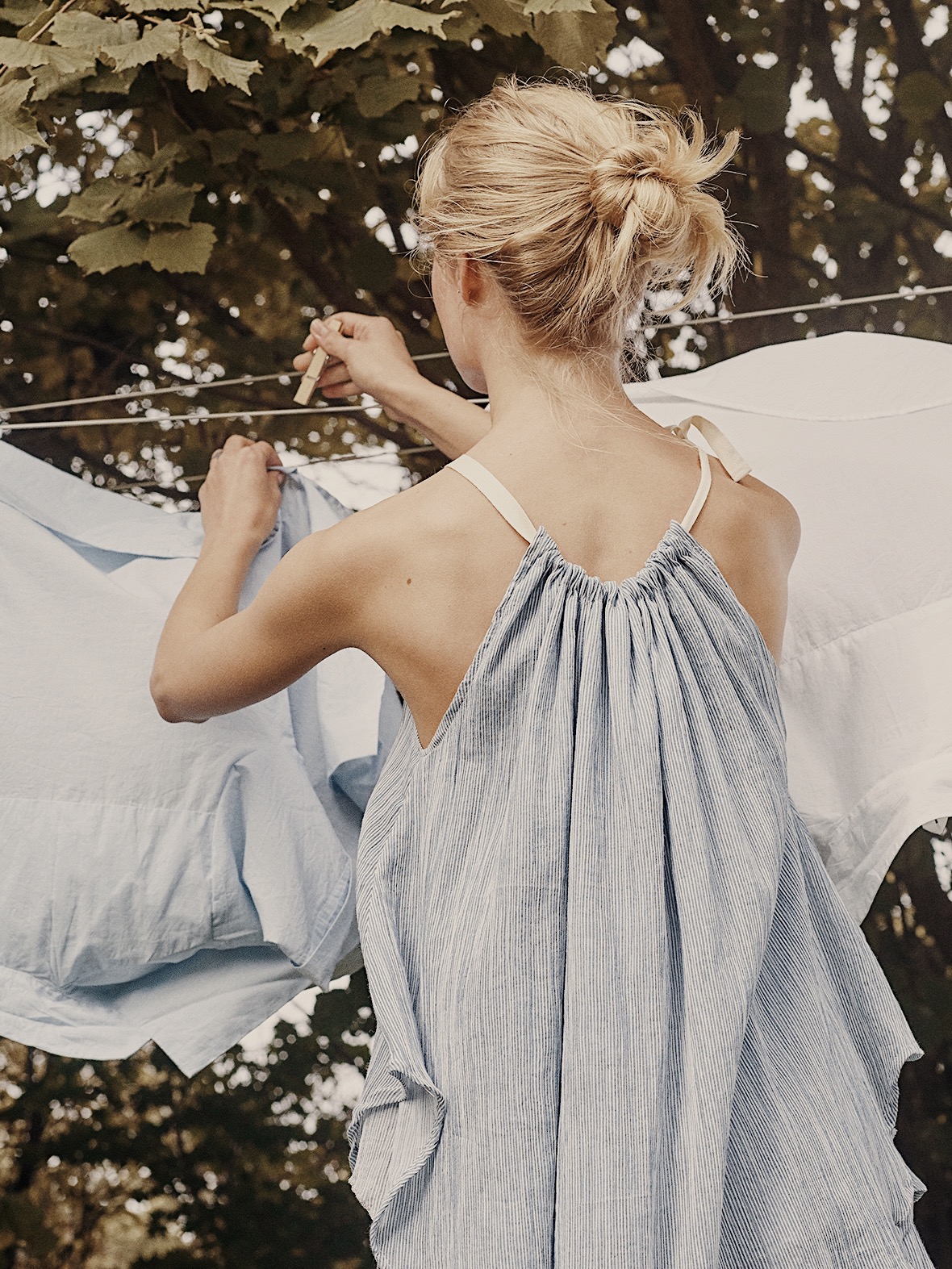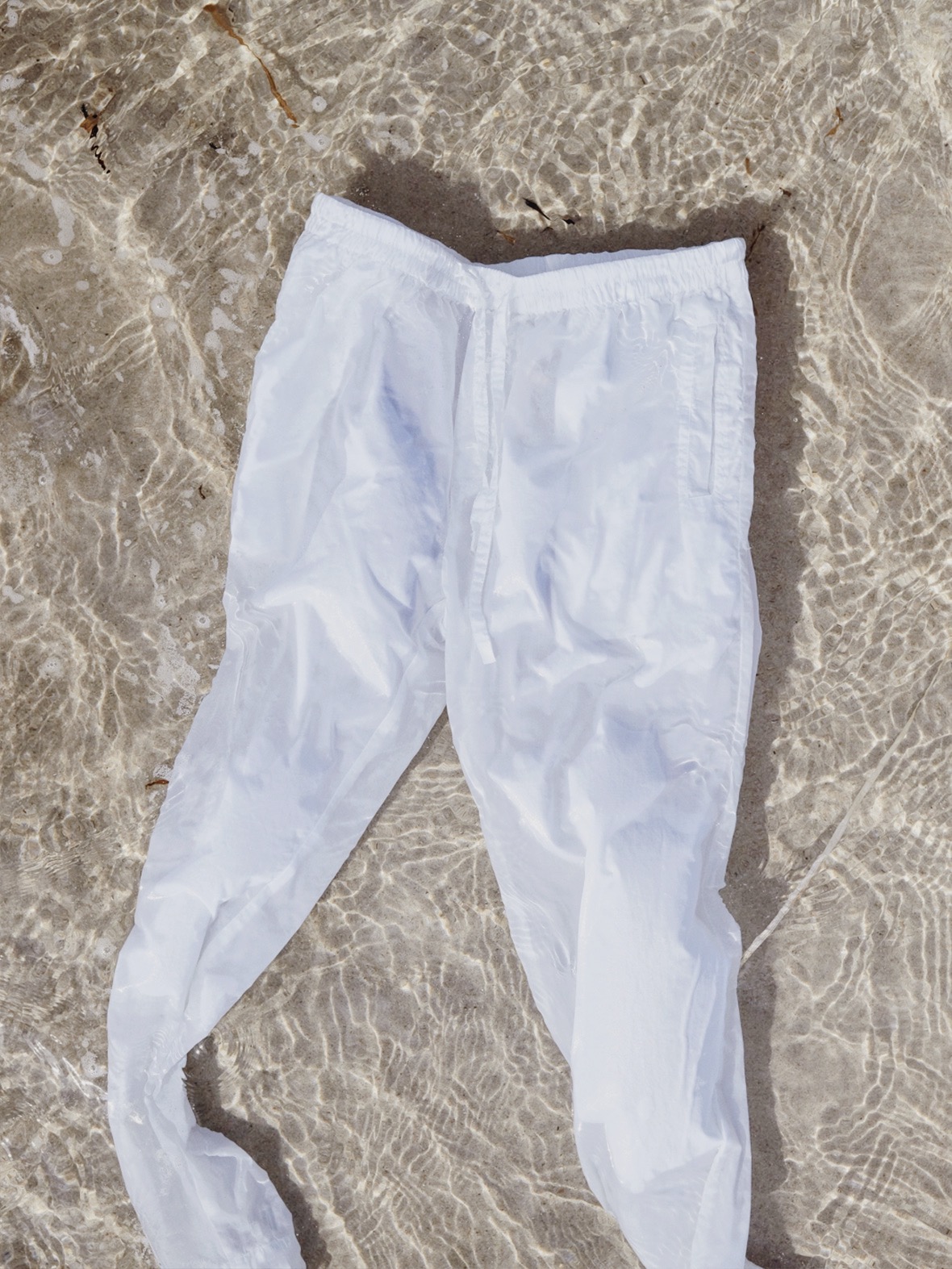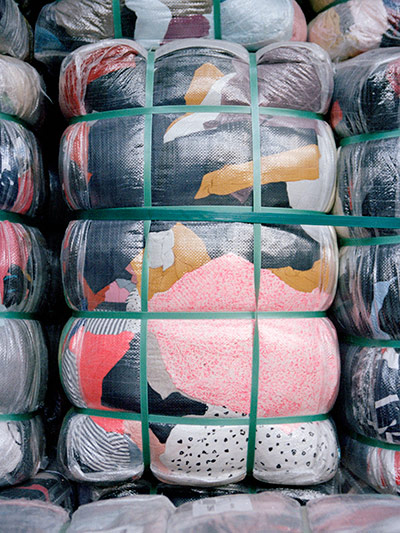What does it mean to take care of your clothes in a sustainable way? Is it only about the materials themselves, or are there other things to keep in mind? Having truly sustainable garment care practices starts from shopping for an item to how often you wear it, to washing it, to storing it, and finally, mending or disposing of it. Think of it as the life cycle of a garment.
We’re sharing the top tips and tricks from sustainable brands, as well as which fibres are most sustainable, what detergents to use, how to keep your clothes in shape, and how to mend them when they break. If you’ve ever had a question about caring for your clothes, this guide is here to help!d
Here’s how to shop for and take care of your clothes so that they last for the longest time possible:
How to shop for the most sustainable clothes
There are a few things to keep in mind when shopping for sustainable clothes. The first is considering whether you need to buy something at all. Sustainable Swedish menswear brand ASKET notes, “We can’t shop our way to sustainability, so a good place to start is to consider if you need to buy something new. The Swedish research institution Mistra Future Fashion says that by wearing a garment twice as many times, its environmental impact can be halved. The research noted that on average, a T-shirt is used 30 times and washed 15 times.”
Once you’ve decided to buy, find out how and by whom the clothes are made. As sustainable Danish brand Organic Basics says in their A-Z Guide to the Fashion Industry, “Ask where it’s made. Ask who made it. Ask because you deserve to know how your clothes are made. They’re your clothes after all.”
Ethical production is a necessary part of sustainability; if it’s not ethically-made, it’s not sustainable. Most websites now have at least a corporate social responsibility (CSR) policy. If they don’t, don’t be afraid to reach out directly to brands. It’s our experience that even brands that have impressive CSR policies sometimes don’t effectively communicate them.
Next, consider how you’ll be using your garment; this will help you decide what fabric is best for you. Things to keep in mind include how often you’re likely to wear it, what kind of tailoring or mending it might require over time, how it will need to be washed, and how you’ll store it.
Shop Organic Basics and get 10% off your entire Organic Basics order with the code SCANDINAVIA10.
 |
 |
Is steaming better than ironing?
For the most part, yes! Steaming is much more gentle on your clothing as the heat of the device doesn’t come into direct contact with the fabric. This is especially true for more delicate fabrics such as silk.
The only time we recommend ironing over steaming is when the wrinkles cannot be removed with steam alone.
 |
 |
Cirrus Travel Steamer by Steamery Stockholm, €120
Get 20% off your Steamery order with the code Scandi20.
How often should I wash my clothes?
As little as possible! This will differ for everyone. It depends on how you wear your clothes, how much you typically sweat, and the fabric of the garment, among other things. There are some fabrics, such as SilverTech, which are antimicrobial and therefore require less washing. Danish brand Organic Basics has a SilverTech collection that includes activewear and undergarments.
Some natural fibres are also antimicrobial, such as alpaca wool. Unless you stain the fabric, alpaca wool needs to be washed very infrequently; in fact, too much washing will damage the material. Instead, treat it like a rug: hit it gently to get out any dust or dirt, and air it out to get rid of slight smells or mustiness.
 |
 |
Above: Aiayu says that if unsure, a good rule of thumb is to wash gently by hand, or at low temperature/low cycle if you use machine.
Are natural fibers better than man-made fibres?
Not always! Although we’ve been led to believe that natural fibres are always superior to manmade ones, this isn’t always the case. In fact, technical and manmade fabrics will be an important part of the future of sustainable fashion and overall textile production.
For example, lyocell is a manmade fabric, created from wood pulp. Growing the trees to create lyocell takes far less water than growing cotton, so it is therefore a more sustainable fabric.
Also important is how you plan to wear a fabric; if you’re working a job that requires intense physical labor, or you’re often in extreme weather, technical fabrics like Gortex can be a smarter choice than, say, wool, because they’ll actually last and won’t tear easily.
Are recycled fabrics as good as new ones?
Well, that depends! When fabric is mechanically recycled, meaning it is physically disassembled so the fibres can be used again, the fibres are necessarily weaker each time you use them. Mechanical recycling is the most commonly-used form of fabric recycling because it is relatively inexpensive. It is fairly easy to recycle items that are 100% cotton, polyester, or wool, but harder to recycle blended fabrics, particularly those with elastane.
Chemical recycling, which is unfortunately still mostly in the testing phase and is quite expensive, actually produces stronger fibres than the garment that preceded it. In this process, the garment is chemically broken down to create new fibres. It only works on single-fibre items and is currently only in use on a large-scale in Asia, with lab testing elsewhere.
Clothing made from recycled plastic, which has become a popular way to reuse plastic, does create strong material, but unfortunately has a down-side: if the item is something you wash frequently, such as a shirt or leggings, it will leak microplastics back into the water. If, however, the item is something you wouldn’t frequently wash in a washing machine, such as a jacket or boots, that’s less of an issue. Recycled plastic still isn’t biodegradable, but at least it’s extending the life of plastic so that it doesn’t end up in a landfill!
If you do have synthetic textile such as recycled plastic, polyester, or other materials known to contain microplastics, we recommend washing them in GUPPYFRIEND, a washing bag that catches microplastics so they can be disposed of properly.
 |
 |
Above: Organic Basics Silvertech Activewear made from recycled materials
What are the best detergents to use on clothes?
Liquid detergents tend to work better on oily stains because they can better break them down, while powder detergent is better of mud stains. But there isn’t a huge difference in effectiveness, so it’s really a matter of what you prefer. Overall, finding a detergent that does not contain phthalates, phosphates, and non-biodegradable surfactants will make your wash as healthy for your skin and the run-off water as possible.
If you plan to wash wool, cashmere, or silk, make sure your detergent is enzyme-free. Enzymes attack these natural fibres, causing the fabric to errode over time.
For an entirely natural detergent, try Soap Nuts. These dried nut husks are made from soapberry and produce saponin when put in water. They are usually sold in bulk; you then take three to five nuts, place them in a small fabric bag, and toss them in with your wash. They’ll act just as a regular detergent would, and each bag of soap nuts lasts approximately five washes.
While the soap nuts are a natural alternative to detergent and are also safe for delicate washes like wool and silk, they are mainly imported from India and Nepal. If you are not local to those areas, it’s worth considering whether the environmental impact of importing them cancels out their benefits.
How to wash fabrics
Cotton
Cotton is a cellulose fibre that comes from Gossypium, the cotton plant. Items that are 100% cotton can shrink easily; to avoid this, make sure to wash in cold or lukewarm water, and spot-treat any stains before washing. When you take a cotton item out of the washing machine, gently shake it to avoid deep wrinkles, and immediately hang or lay flat to air-dry. Do not tumble dry pure cotton.
If the item does get wrinkled, use a steamer or, if necessary, an iron.
 |
 |
Above: Aiayu cotton
Silk
Silk is a delicate fibre made from the cocoons of silkworms. The best way to clean silk is by hand in cold water. Items that aren’t overly delicate (for example, vintage pieces) can be put in the washing machine, but should be washed only with like-items (other silks and delicates) in cold water. Make sure to use enzyme-free detergent so as not to damage the fabric.
It is best to steam silk. If an iron must be used, make sure it is on the lowest possible temperature.
Wool and Cashmere
Wool is a natural fibre that comes from sheep, alpaca, llama, or other animals, while cashmere comes from goats. June at sustainable Danish brand Aiayu, says: “At Aiayu we are partial to wool, especially llama wool. Llama wool is a self-cleaning fibre, and because the fibres are long, it does not pill easily. To reduce the effects of daily use – simply air it instead of washing it. Airing will rid of most smells and odours, give it a fresh look and feel, and the added bonus of the scent of fresh air that you simply cannot get in any other way.”
She continues, “for minor spills, spot-wash gently by hand under cold water. To retain shape always fold and lay woolens flat instead of using a hanger. Keep moth infestations at bay by using your woolens regularly. When storing them away for the summer, pack in an airtight container with dried cedar as a natural repellant. If you are unfortunate to get a moth infestation – freeze the item before repairing.”
If your wool or cashmere begins to pill, use a fabric shaver or comb to gently remove the pilling. A mark of really good wool and cashmere is that it seldom pills; instead, it becomes slightly shiny and develops a patina. This can be found in really high-quality items and often in thick vintage pieces.

Steamery Pilo Fabric Shaver, €40
Get 20% off your Steamery order with the code Scandi20.
 |
 |
Above: Aiayu wool
Blended textiles
Blended fabrics are usually quite durable. It’s most important to pay attention to the natural fibres, if any, in the item. For example, does it contain cotton, wool, or silk? If so, try to care for it as if it were entirely made of that fabric in order to best preserve it.
Man-made textiles
Man-made textiles such as polyester can be washed on medium heat in a washing machine. Even the most durable items shouldn’t be washed in very hot water unless absolutely necessary, as this distresses the fabric.
How to mend your clothes
Mending clothes is an invaluable skill. Being able to sew a button, ripped seam, or patch will ensure that your clothes remain useful regardless of normal wear-and-tear. You’re much more likely to simply mend your clothes and continue to wear them when you have these skills, as opposed to throwing them away. If you don’t already know how to sew a button or other relatively simple mending tasks, YouTube has some great tutorials:
Larger or more complex repairs may require a sewing machine. If you don’t have access to a sewing machine, you may not be able to mend thicker items like leather and denim. It may also be difficult to mend extremely frayed edges or large holes. For situations like these, find a local tailor! Getting to know your local tailor is a great investment for your clothes.
Some brands have years-long guarantees for their garments, or offer repair services. One such brand is Swedish denim company Nudie Jeans. Their website explains, “Denim is not armor. The more you wear your jeans, the closer they get to that rainy day when a rip occurs. Fortunately we’ve got the remedy. As we provide the jeans, we also take care of them when they’re torn.” Nudie offers lifetime repairs on all of their jeans, and also recycles any Nudie pair you no longer want.
Feeling empowered to mend your clothes, or have experts do it, not only makes your clothing lasts for longer, but makes you feel more invested in your purchases. When you know that the item you’re buying will last for a long time, you can feel good about your choice.
ASKET notes, “we’ve become used to replacing instead of repairing, which is hardly surprising, with a t-shirt costing less than a Big Mac. Fast fashion brands have been feeding a throwaway culture. Yet, as a consumer the single best thing you can do reduce your impact is keep your garments for longer. It decreases the need to buy more and in the long run reduces an individual’s demand on the planet’s resources as well as reducing their waste output.”
The best way to get rid of old clothes
Keep your clothes for as long as possible. Sometimes, of course, an item can no longer be worn, or you simply know you won’t get further use from it.
If an item is still wearable, give it to a friend, take it to a consignment store, donate it to a thrift shop, or repurpose it.
If the garment is no longer wearable, recycle it. This doesn’t just mean dumping it in your nearest second-hand bin. Instead, find a service in your area that recycles textiles. A few large brands do this at their stores, including ARKET, H&M, Levi’s, and The North Face. You can also find your nearest textile recycling location using the Recycle Now website (USA only).
 |
 |
TerraCycle offers a wonderful service; you order a box from them, fill it with clothing, then send it directly to them for zero-waste recycling.

